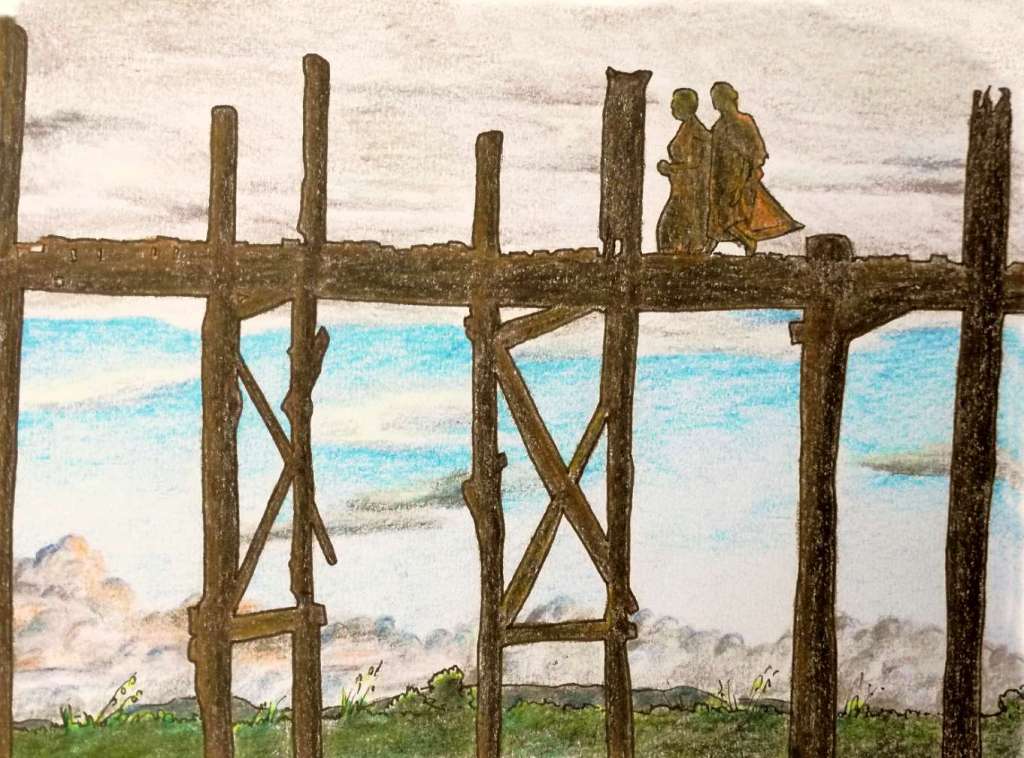U Bein Bridge near Mandalay, Myanmar is one of the country’s most remarkable sights. The wooden foot bridge spans the Taungthaman Lake near Amarapura, part of Mandalay. Dating to the 19th century, it is thought to be the oldest and longest teakwood bridge in the world. The bridge has a fascinating history, a unique design, and a stunning scenery (especially during sunset!) that attracts locals and visitors alike.

About U Bein Bridge
The bridge was built between 1849 and 1851 by the order of Maung Bein (U Bein), a mayor of Amarapura. The bridge was constructed to ease passage over Taungthaman Lake for the people living in the area. The teak wood used in its construction was salvaged from the former royal palace of Inwa, a ruined former capital of Myanmar that had been repeatedly sacked by invaders, and ultimately destroyed by earthquake.
U Bein bridge is impressive in scale, measuring 1.2 kilometers (0.75 miles) long and supported by 1,089 massive wooden pillars that support the walkway above. As it crosses the lake, it arcs in a curve shape across the water to better weather the wind and current. It features four covered pavilions along its length, and 9 crossing points, where floors can be lifted up to allow boats to pass.
Due to its age and style, the bridge is accessible only to pedestrians and cyclists, and has no railings or safety features.
Cultural Importance
As one of the oldest and most notable structures in the area, the bridge is a celebrated historical monument. However, it’s also in daily use by monks, vendors, farmers, fishermen, and more, who cross the lake during their daily life.
The bridge also hosts cultural events, religious ceremonies, and festivals throughout the year. In the dry season (mid-February to mid-May), the water level of the lake drops and exposes the muddy lake bed, ideal for growing vegetables, whilst higher lake levels are best for fishermen.
U Bein bridge is also a favourite location for photographers and visitors who come to admire the scenic panoramic views of the lake and the bridge. Particularly beautiful during sunset and sunrise, the bridge illuminates in warm glows, with otherworldly silhouettes of the wooden skeletal frame.
Repairs and Restoration
Having stood for over 170 years, U Bein bridge is facing issues because of natural and human factors. Due to decay and damage caused by floods, erosion, and termites, many of the wooden pillars have been replaced with concrete pillars. Others are detached, and are dangerously held in place. Some original teak planks have also been eroded over time, or stolen by locals.
The bridge is protected by the Myanmar Ministry of Culture’s Department of Archaeology, National Museum and Library. Planned works to restore and repair U Bein bridge are being planned. The bridge is also supported by local communities and organisations that value its cultural and historical significance. The bridge is frequently recognised as a national heritage site and an important tourist attraction.
***
U Bein Bridge is one of the most impressive structures in Myanmar, and a symbol of the country’s history and culture. Brilliantly built on tall pillars, and stretching out far across the lake waters, it is a must see for anybody lucky enough to visit Myanmar.